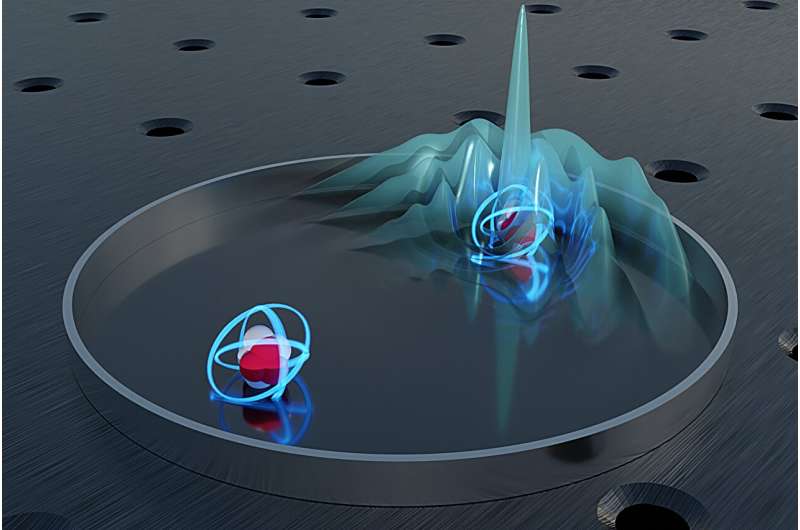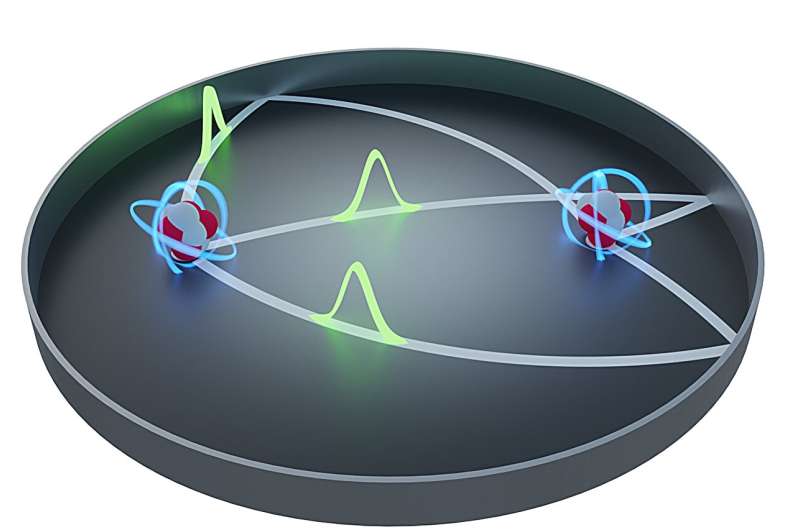This article has been reviewed according to Science X's editorial process and policies. Editors have highlighted the following attributes while ensuring the content's credibility:
fact-checked
peer-reviewed publication
trusted source
proofread
'Quantum ping-pong': Two atoms can be made to bounce a single photon back and forth with high precision

Atoms can absorb and reemit light—this is an everyday phenomenon. In most cases, however, an atom emits a light particle in all possible directions—recapturing this photon is, therefore, quite hard.
A research team from TU Wien in Vienna (Austria) has now been able to demonstrate theoretically that using a special lens, a single photon emitted by one atom can be guaranteed to be reabsorbed by a second atom. This second atom not only absorbs the photon though, but directly returns it back to the first atom. That way, the atoms pass the photon to each other with pinpoint accuracy again and again—just like in ping-pong.
How to tame a wave
"If an atom emits a photon somewhere in free space, the direction of emission is completely random. This makes it practically impossible to get another distant atom to catch this photon again," says Prof. Stefan Rotter from the Institute of Theoretical Physics at TU Wien. "The photon propagates as a wave, which means that nobody can say exactly in which direction it is traveling. It is, therefore, pure chance whether the light particle is reabsorbed by a second atom or not."
The situation is different if the experiment is not carried out in free space but in an enclosed environment. Something quite similar is known from so-called whispering galleries in acoustics: if two people place themselves in an elliptical room exactly at the focal points of the ellipse, they can hear each other perfectly—even when only whispering quietly.
The sound waves are reflected by the elliptical wall in such a way that they meet again exactly where the second person is standing—this person can, therefore, hear the quiet whisper perfectly.
"In principle, something similar could be built for light waves when positioning two atoms at the focal points of an ellipse," says Oliver Diekmann, the first author of the current publication. "But in practice, the two atoms would have to be positioned very precisely at these focal points."
The Maxwell fish-eye lens
The research team, therefore, came up with a better strategy based on the concept of the fish-eye lens, which was developed by James Clerk Maxwell, the founder of classical electrodynamics. The lens comprises a spatially varying refractive index. While light travels in straight lines in a uniform medium such as air or water, light rays are bent in a Maxwell fish-eye lens.
"In this way, it is possible to ensure that all rays emanating from one atom reach the lens's edge on a curved path, are subsequently reflected, and then arrive at the target atom on another curved path," explains Oliver Diekmann. In this case, the effect works much more efficiently than in a simple ellipse, and deviations from the ideal positions of the atoms are less harmful.

"The light field in this Maxwell fish-eye lens consists of many different oscillatory modes. This is reminiscent of playing a musical instrument where different harmonics are generated at the same time," says Stefan Rotter. "We were able to show that the coupling between the atom and these different oscillating modes can be adapted in such a way that the photon is transferred from one atom to the other one almost certainly—quite different from what would be the case in free space."
Once the atom has absorbed the photon, it is left in a state of higher energy until it reemits the photon after a very short time. Then the game starts over: the two atoms swap roles, and the photon is returned from the receiver atom to the original sender atom—and so on.
The effect has been demonstrated theoretically, but practical tests are possible with today's technology. "In practice, the efficiency could be increased even further by using not just two atoms, but two groups of atoms," says Stefan Rotter. "The concept could be an interesting starting point for quantum control systems to study effects at extremely strong light-matter interaction."
The work is published in the journal Physical Review Letters.
More information: Oliver Diekmann et al, Ultrafast Excitation Exchange in a Maxwell Fish-Eye Lens, Physical Review Letters (2024). DOI: 10.1103/PhysRevLett.132.013602
Journal information: Physical Review Letters
Provided by Vienna University of Technology




















